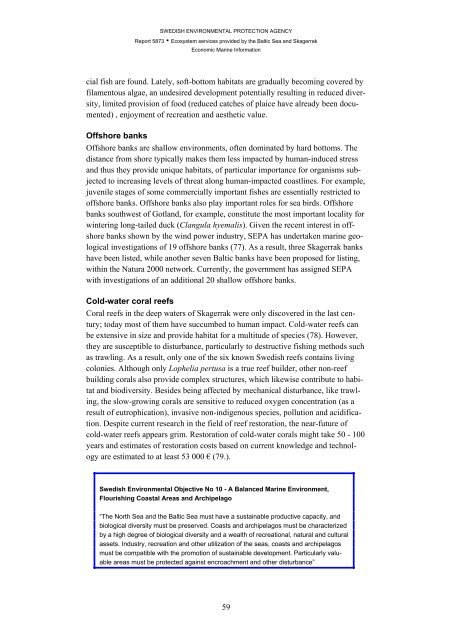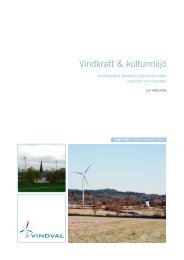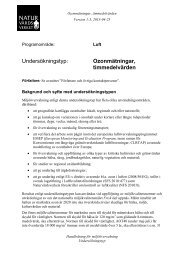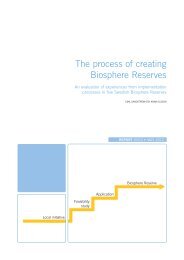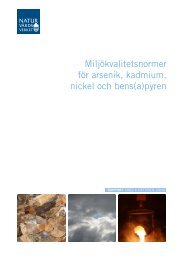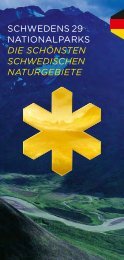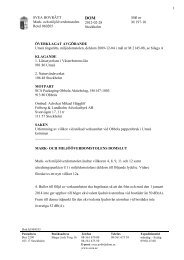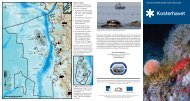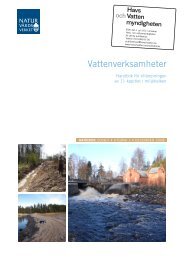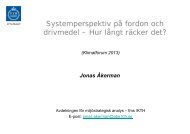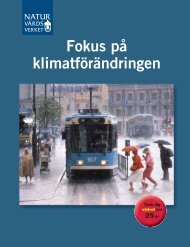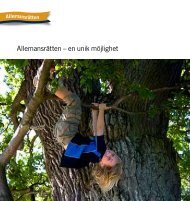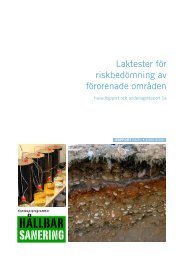Ecosystem services provided by the Baltic Sea ... - Naturvårdsverket
Ecosystem services provided by the Baltic Sea ... - Naturvårdsverket
Ecosystem services provided by the Baltic Sea ... - Naturvårdsverket
Create successful ePaper yourself
Turn your PDF publications into a flip-book with our unique Google optimized e-Paper software.
SWEDISH ENVIRONMENTAL PROTECTION AGENCY<br />
Report 5873 • <strong>Ecosystem</strong> <strong>services</strong> <strong>provided</strong> <strong>by</strong> <strong>the</strong> <strong>Baltic</strong> <strong>Sea</strong> and Skagerrak<br />
Economic Marine Information<br />
cial fish are found. Lately, soft-bottom habitats are gradually becoming covered <strong>by</strong><br />
filamentous algae, an undesired development potentially resulting in reduced diversity,<br />
limited provision of food (reduced catches of plaice have already been documented)<br />
, enjoyment of recreation and aes<strong>the</strong>tic value.<br />
Offshore banks<br />
Offshore banks are shallow environments, often dominated <strong>by</strong> hard bottoms. The<br />
distance from shore typically makes <strong>the</strong>m less impacted <strong>by</strong> human-induced stress<br />
and thus <strong>the</strong>y provide unique habitats, of particular importance for organisms subjected<br />
to increasing levels of threat along human-impacted coastlines. For example,<br />
juvenile stages of some commercially important fishes are essentially restricted to<br />
offshore banks. Offshore banks also play important roles for sea birds. Offshore<br />
banks southwest of Gotland, for example, constitute <strong>the</strong> most important locality for<br />
wintering long-tailed duck (Clangula hyemalis). Given <strong>the</strong> recent interest in offshore<br />
banks shown <strong>by</strong> <strong>the</strong> wind power industry, SEPA has undertaken marine geological<br />
investigations of 19 offshore banks (77). As a result, three Skagerrak banks<br />
have been listed, while ano<strong>the</strong>r seven <strong>Baltic</strong> banks have been proposed for listing,<br />
within <strong>the</strong> Natura 2000 network. Currently, <strong>the</strong> government has assigned SEPA<br />
with investigations of an additional 20 shallow offshore banks.<br />
Cold-water coral reefs<br />
Coral reefs in <strong>the</strong> deep waters of Skagerrak were only discovered in <strong>the</strong> last century;<br />
today most of <strong>the</strong>m have succumbed to human impact. Cold-water reefs can<br />
be extensive in size and provide habitat for a multitude of species (78). However,<br />
<strong>the</strong>y are susceptible to disturbance, particularly to destructive fishing methods such<br />
as trawling. As a result, only one of <strong>the</strong> six known Swedish reefs contains living<br />
colonies. Although only Lophelia pertusa is a true reef builder, o<strong>the</strong>r non-reef<br />
building corals also provide complex structures, which likewise contribute to habitat<br />
and biodiversity. Besides being affected <strong>by</strong> mechanical disturbance, like trawling,<br />
<strong>the</strong> slow-growing corals are sensitive to reduced oxygen concentration (as a<br />
result of eutrophication), invasive non-indigenous species, pollution and acidification.<br />
Despite current research in <strong>the</strong> field of reef restoration, <strong>the</strong> near-future of<br />
cold-water reefs appears grim. Restoration of cold-water corals might take 50 - 100<br />
years and estimates of restoration costs based on current knowledge and technology<br />
are estimated to at least 53 000 € (79.).<br />
Swedish Environmental Objective No 10 - A Balanced Marine Environment,<br />
Flourishing Coastal Areas and Archipelago<br />
“The North <strong>Sea</strong> and <strong>the</strong> <strong>Baltic</strong> <strong>Sea</strong> must have a sustainable productive capacity, and<br />
biological diversity must be preserved. Coasts and archipelagos must be characterized<br />
<strong>by</strong> a high degree of biological diversity and a wealth of recreational, natural and cultural<br />
assets. Industry, recreation and o<strong>the</strong>r utilization of <strong>the</strong> seas, coasts and archipelagos<br />
must be compatible with <strong>the</strong> promotion of sustainable development. Particularly valuable<br />
areas must be protected against encroachment and o<strong>the</strong>r disturbance”<br />
59


